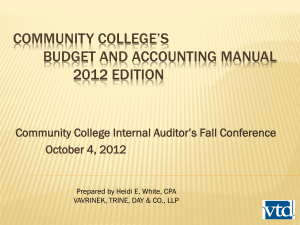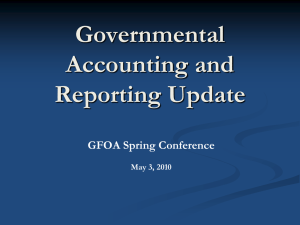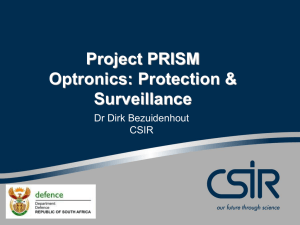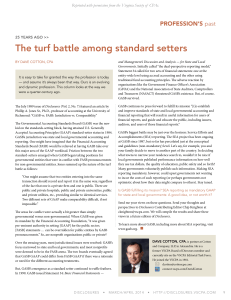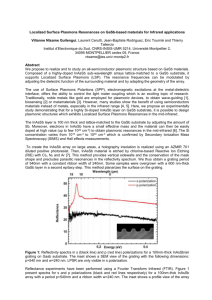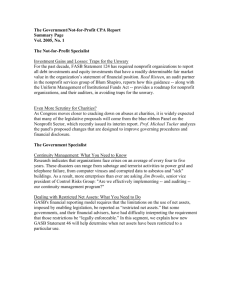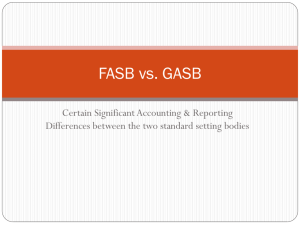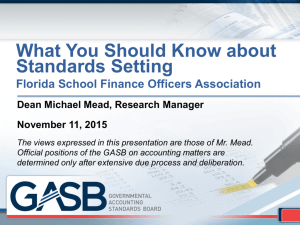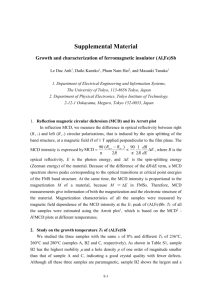GASB #34: Problems and Solutions During
advertisement
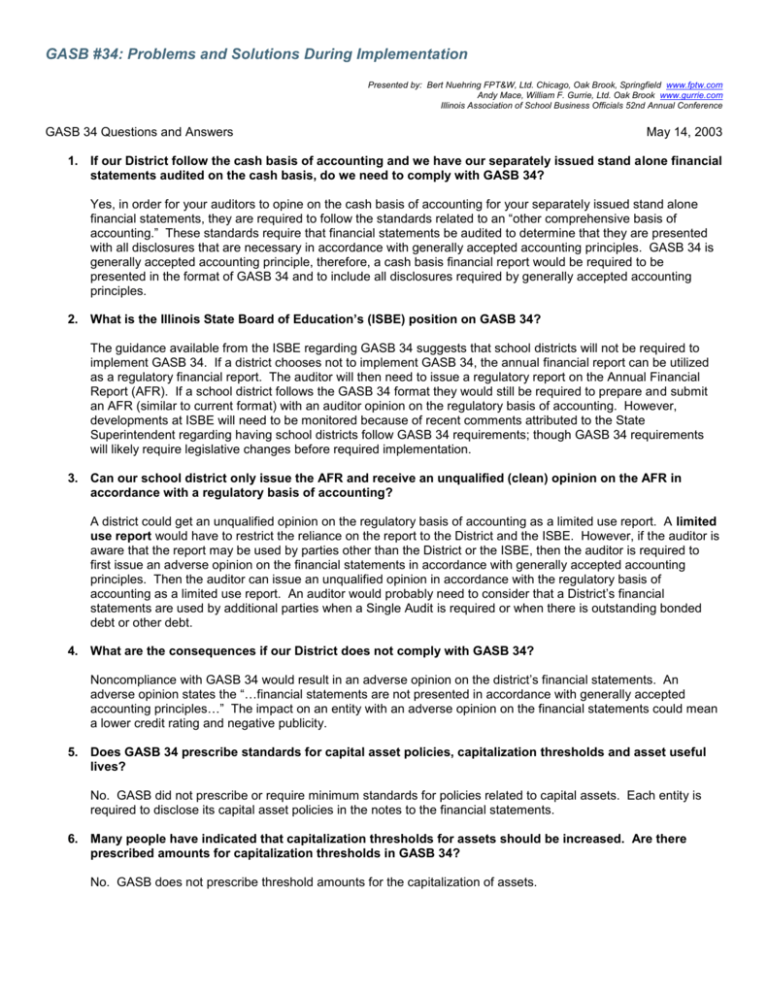
GASB #34: Problems and Solutions During Implementation Presented by: Bert Nuehring FPT&W, Ltd. Chicago, Oak Brook, Springfield www.fptw.com Andy Mace, William F. Gurrie, Ltd. Oak Brook www.gurrie.com Illinois Association of School Business Officials 52nd Annual Conference GASB 34 Questions and Answers May 14, 2003 1. If our District follow the cash basis of accounting and we have our separately issued stand alone financial statements audited on the cash basis, do we need to comply with GASB 34? Yes, in order for your auditors to opine on the cash basis of accounting for your separately issued stand alone financial statements, they are required to follow the standards related to an “other comprehensive basis of accounting.” These standards require that financial statements be audited to determine that they are presented with all disclosures that are necessary in accordance with generally accepted accounting principles. GASB 34 is generally accepted accounting principle, therefore, a cash basis financial report would be required to be presented in the format of GASB 34 and to include all disclosures required by generally accepted accounting principles. 2. What is the Illinois State Board of Education’s (ISBE) position on GASB 34? The guidance available from the ISBE regarding GASB 34 suggests that school districts will not be required to implement GASB 34. If a district chooses not to implement GASB 34, the annual financial report can be utilized as a regulatory financial report. The auditor will then need to issue a regulatory report on the Annual Financial Report (AFR). If a school district follows the GASB 34 format they would still be required to prepare and submit an AFR (similar to current format) with an auditor opinion on the regulatory basis of accounting. However, developments at ISBE will need to be monitored because of recent comments attributed to the State Superintendent regarding having school districts follow GASB 34 requirements; though GASB 34 requirements will likely require legislative changes before required implementation. 3. Can our school district only issue the AFR and receive an unqualified (clean) opinion on the AFR in accordance with a regulatory basis of accounting? A district could get an unqualified opinion on the regulatory basis of accounting as a limited use report. A limited use report would have to restrict the reliance on the report to the District and the ISBE. However, if the auditor is aware that the report may be used by parties other than the District or the ISBE, then the auditor is required to first issue an adverse opinion on the financial statements in accordance with generally accepted accounting principles. Then the auditor can issue an unqualified opinion in accordance with the regulatory basis of accounting as a limited use report. An auditor would probably need to consider that a District’s financial statements are used by additional parties when a Single Audit is required or when there is outstanding bonded debt or other debt. 4. What are the consequences if our District does not comply with GASB 34? Noncompliance with GASB 34 would result in an adverse opinion on the district’s financial statements. An adverse opinion states the “…financial statements are not presented in accordance with generally accepted accounting principles…” The impact on an entity with an adverse opinion on the financial statements could mean a lower credit rating and negative publicity. 5. Does GASB 34 prescribe standards for capital asset policies, capitalization thresholds and asset useful lives? No. GASB did not prescribe or require minimum standards for policies related to capital assets. Each entity is required to disclose its capital asset policies in the notes to the financial statements. 6. Many people have indicated that capitalization thresholds for assets should be increased. Are there prescribed amounts for capitalization thresholds in GASB 34? No. GASB does not prescribe threshold amounts for the capitalization of assets. 7. If we increase capitalization thresholds, won’t we be losing valuable information for the insurable assets? It is recommended that consideration be made for maintaining a ledger for accounting purposes and another ledger for property control purposes. The accounting ledger would maintain information regarding assets capitalized according to the accounting policy. A separate property control ledger will use a lower threshold. This ledger will be used for property control and insurance purposes. 8. Which revenues should be considered program revenues for presentation on the Statement of Activities? Generally, GASB 34 requires that program revenues meet the following definitions: Program revenues derive directly form the program itself or from parties outside the district’s taxpayers or citizenry. There are three categories of program revenues: a. Charges for services – these revenues directly arise from charges to customers or applicants who purchase, use, or directly benefit from the goods, services or privileges provided. b. Program – specific operating grants and contributions – these revenues arise from transactions with other governments, organizations or individuals that are restricted for use in a particular program. c. Program specific capital grants and contributions – these revenues are similar to program-specific operating grants and contributions, except that they involve funds that are to be restricted for capital purposes. Capital purposes include that purchasing, constructing or renovating capital assets associated with a specific program. Specifically, some of the following revenues by source could be considered as program revenues: NCES Title Property taxes Payments in lieu taxes Interfund payments Payments for services (tuition) Food service sales Non-capital sales School activity income Interest on investments Other local revenue Interdistrict transit of aids Interdistrict tuition payment Other interdistrict payments Intermediate transit of aids Intermediate payment for services Other intermediate payments Categorical state aid General state aid State payments for special projects State tuition payments State payments through local units Federal categorical aid Federal impact aid Federal payments for special projects Gain or loss sale of fixed assets Refund of prior year disbursements PROGRAM REVENUES Operating Capital Charges for Grants and Grants and Services Contributions Contributions Potentially Generally Always Generally Generally Potentially Potentially Potentially Generally Potentially Potentially Generally Potentially Potentially Potentially Potentially Potentially Potentially Potentially Potentially Potentially Potentially Potentially Potentially Potentially Potentially Generally Potentially Generally General Purpose Always Always Potentially Potentially Special/ Extraordinary Items Potentially Potentially Generally Generally Potentially Potentially Potentially Potentially Potentially Potentially Potentially Always Potentially Potentially Generally Generally Potentially Generally Generally Potentially Potentially Generally Generally 9. Our district currently has a working cash fund that is presented as an expendable trust fund in our financial statements. Under GASB 34, expendable trust funds no longer exist as a fund type. How will the working cash fund be classified under GASB 34? The working cash fun would likely be considered a special revenue fund under GASB 34. 10. Our district has a Section 457 deferred compensation plan that is not trusted. In the past we have presented this fund as a fiduciary fund. How will this fund be presented under GASB 34? It will be presented as a Fiduciary fund type, pension trust fund. 11. Some examples of GASB 34 style financial statements show the school lunch activities as Business Type Activities (BTA) or proprietary funds. Is it a requirement that these activities be presented as business type or proprietary funds? No. GASB 34 indicates that following requirements for proprietary funds: Proprietary enterprise funds may be used to report any activity for which a fee is charged to external users for goods or services. Activities are required to be reported as enterprise funds if any one of the following criteria is met. Governments should apply each of these criteria in the context of the activity’s principal revenue sources: a. Activity is financed with debt that is secured solely by a pledge of the net revenue from fees and charges of the activity. b. Laws or regulations that the activity’s costs of providing services be recovered with fees and charges, rather than with taxes or similar revenues. c. The pricing policies of the activity establish fees and charges designed to recover its cost, including depreciation and other overhead. 12. What is the Illinois Community College Board’s (ICCB) position on GASB 34/35? ICCB issued guidance to community colleges on May 16, 2002. Generally, the guidance indicates the following: Property taxes should be recorded according to GASB 33. Receivables and deferred revenue should be recorded when passed by the Board. Corporate personal property tax should be recorded according to GASB 33, example 5, when the tax is measurable and available. Depreciation should be recorded in the GFAAG. Capitalization thresholds are as follows: o $2,500-$5,000 o For remodeling that extends the life of a building: $50,000-$100,000 Useful life guidelines: o Buildings: 40-60 years o Land Improvements: 10-20 years o Equipment: 5-10 years o Technology related software and hardware: 3-5 years o Vehicles: 3-5 years Acceptable depreciation methods: o Straight line o Double declining balance o Sum of the years digits Summer school revenue and expense should be reported in the subsequent fiscal year. Recommend the BTA model. IF BTA is not used, ICCB requires BTA as supplemental information for any other model. The consolidation financial reporting method should be used for GASB 35 reporting. Elimination and adjustment entries should be made in the consolidated statement: o Elimination of internal service charges and equivalent expenditures o Funds to be provided should be eliminated from the LTDAG o Interfund due to/from should be netted o Scholarships and Pell grants provided for tuition and fees should offset tuition revenues as an allowance. 13. What are sources of material to assist in the implementing of GASB 34? There are number of sources of guidance related to the implementation of GASB 34. Some of those sources include the following: Association of School Business Officials – 703-478-0405 o GASB Statement No. 34, Implementation Recommendations for School Districts o Implementing GASB 34 Government Finance Officer’s Association – 312-977-9700 o GAAFR o An Elected Official’s Guide to GASB 34 Government Accounting Standards Board – 203-847-0700 o Guide to Implementation of GASB Statement 34 and Related Pronouncements o Guide to Implementation of GASB 34 on Basic Financial Statements – and Management’s Discussion and Analysis – for State and Local Governments o GASB Statement No. 33, Accounting and Financial Reporting for Nonexchange Transactions o GASB Statement No. 34, Basic Financial Statements – and Management’s Discussion and Analysis – for State and Local Governments o GASB Statement No. 34, Implementation Guides, (Vol. 1 and 2) o GASB Statement No, 35, Basic Financial Statements – and Management’s Discussion and Analysis – for Public Colleges and Universities – an amendment of GASB Statement No. 34 o GASB Statement No. 36, Recipient Reporting for Certain Shared Nonexchange Revenues – an amendment of GASB Statement No. 33 o GASB Statement No. 37, Basic Financial Statements – and Management’s Discussion and Analysis – for State and Local Governments: Omnibus-an amendment of GASB Statements No. 21 and No. 34 National Association of College and University Business Officers – 202-861-2500 o GASB 35 Implementation Guide
